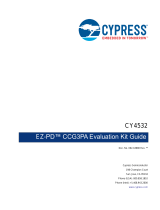
Quick Start Guide
2
• i.MX6SLsingleARMCortex-A9
coreoperatingupto1GHz
• 1GBLPDDR2(400MHz)
• SPINOR
• SDsocketforexternaldevices
• SDsocketforbootcode
• SDsocketforWi-Fi
®
andaccessories
• eMMCexpansionfootprint
• Audiocodec
• EPDCexpansionport
• Paralleldisplayport
• PortforCSICMOSsensor(camera)
• SIMcardslot
• Buttonmatrix
• Ethernet
• Lithiumbatterycharger
• USBhost,USBOTGandUSBto
UARTports
Aboutthei.MX6SoloLiteEvaluationKit
Thei.MX6SoloLiteevaluationkit(EVK)offersasolidplatformtoevaluatethei.MX
6seriessingle-coreprocessorbuiltonARM
®
Cortex
™
-A9technologyaswellasa
referenceforfuturedesigns.Keyfeaturesofthisplatforminclude:

5
i.MX 6Series
GettoKnowthei.MX6SoloLiteEVK(bottom)
5 V Power
Jack
Mini PCIe
(Only USB
connection
is supplied
for Mini PCIe
connector)
USB Host
USB OTG
Li Cell
Connectors
On/Off
Switch
Ethernet
Connector
JTAG
Connector
Boot Mode
Selection
Switch
USB to UART
Connector
Boot
Selection
Switches
Headphone
Connector
Speaker
Out
eMMC
Expansion
Footprint
SD Socket for Wi-Fi
and SD Accessories
(SD3)
SD Socket for Primary
External Card Slot
(SD1)
SD Socket for
Boot Code
(SD2)

Quick Start Guide
6
SettinguptheBoard
Insert SD
Card
InsertthesuppliedSDcardinto
theSD2cardslot.
Set Up Boot
Switches
Bydefault,bootswitchesare
configuredtobootfromSD2.Ifany
otherbootsourceisdesired,boot
switcheshavetobeconfigured
accordingtoTable1.
Connect USB to
UART Cable
ConnectfromUSBtoUARTport
(J26)usingamicroUSBcableto
PC.OncethePCrecognizesthe
virtualUSBtoUARTdevice,it
canbeseenitinyourPCDevice
Managerlist.
Serialportconfiguration:115.2
Kbaud,8databits,1stopbit,
noparity.
Note:ThePCneedsadriverto
enableavirtualCOMportthrough
thePCUSBport.
Visitftdichip.comtodownload
thecorrectdriver.
Connect EPDC or
Parallel Display
Connectbymeansofthe
IMXEBOOKDC3-Eboard,which
hastobeconnectedtoJ12
andJ13.Formoreinformation
aboutthisboard,pleasevisit
freescale.com.
Connect Power
Supply
Connect5Vpowersupplyinto
powerjackJ6andsetSW14to
theOnposition(seetable2).
2
1
4
3
5

7
i.MX 6Series
Thei.MX6SoloLiteEVKiscompatiblewiththefollowingdaughtercardsthroughthe
LCDextensionslot:
• MCIMX28LCD—LCDdaughtercard*
• MCIMXHDMICAR—HDMIdaughtercard
• IMXEBOOKDC3—EPDdaughtercard
*
EVK does not natively support the resistive touch screen on the LCD cards.
It does support touch on the EPD cards.
J13 J12

Quick Start Guide for TWRPI-MMA845xQQuick Start Guide
8
TheAndroidBSPisprovidedontwodifferentSDcards,dependinguponthedisplay
daughtercardused.
LCD/HDMI SD Card for Booting Android
ThedefaultbootmodeconfiguresthesystemtodisplaytheUIontheMCIMX28LCD
(soldseparately).
TochangethedefaultconfigurationandenabletheMCIMXHDMICARdaughtercard
(soldseparately),hitanykeytostopu-bootfromproceeding.Oncepromptisvisible,
theu-bootcanbeconfiguredasfollows:
ForLCDbootup,typethefollowingcommands(asoneline):
setenv bootargs console=ttymxc0,115200 init=/init
androidboot.console=ttymxc0 panel=lcd
saveenv
reset
ForHDMIbootup,typethefollowingcommands(asoneline):
setenv bootargs console=ttymxc0,115200 init=/init
androidboot.console=ttymxc0 panel=hdmi
saveenv
reset
EPDC SD Card for Booting Android
Thedefaultsettingsshouldbeusedandnochangeisneeded.

9
i.MX 6Series
Table 1: Boot Options
S1_2 S1_1
BOOT_MODE1 BOOT_MODE0
Bootfromfuses 0 0
Serialdownloader 0 1
Internalboot 1 0
Reserved 1 1
BootOptionsandSwitchConfiguration
Table 2: SW3 Configuration
SW3_8 SW3_7 SW3_6 SW3_5 SW3_4 SW3_3 SW3_2 SW3_1
BT_CFG1_0 BT_CFG1_1 BT_CFG1_2 BT_CFG1_3 BT_CFG1_4 BT_CFG1_5 BT_CFG1_6 BT_CFG1_7
SD1
D
* ** * * * 0 1 0
SD2
* ** * * * 0 1 0
SD3
* ** * * * 0 1 0
SD4
* ** * * * 0 1 0
eMMC
X X * * * 1 1 0
SPINOR
X X X X 1 1 0 0
X Nonespecified
D
Defaultconfiguration
* Switchneedstobeconfiguredforhighorlowdependingontheapplicationneeds.Pleasecheckreferencemanualfor
bootconfigurationoptions
** 1=powercycleonpower-upviaSDa_RST_B(SD3_RST).0=nopowercycle

Quick Start Guide
10
Table 3: SW4 Configuration
SW4_8 SW4_7 SW4_6 SW4_5 SW4_4 SW4_3 SW4_2 SW4_1
BT_CFG2_0 BT_CFG2_1 BT_CFG2_2 BT_CFG2_3 BT_CFG2_4 BT_CFG2_5 BT_CFG2_6 BT_CFG2_7
SD1 * X X 0 0 1 * *
SD2
D
* X X 1 0 1 * *
SD3 * X X 0 1 1 * *
SD4 * X X 1 1 1 * *
eMMC * * * 1 0 0 1 1
SPINOR X X X X X X X X
Table 4: SW5 Configuration
SW5_8 SW5_7 SW5_6 SW5_5 SW5_4 SW5_3 SW5_2 SW5_1
BT_CFG4_0 BT_CFG4_1 BT_CFG4_2 BT_CFG4_3 BT_CFG4_4 BT_CFG4_5 BT_CFG4_6 BT_CFG4_7
SD1 X X X X X X X X
SD2
D
X X X X X X X X
SD3 X X X X X X X X
SD4 X X X X X X X X
eMMC X X X X X X X X
SPINOR 0 0 0 1 0 0 X X
BootOptionsandSwitchConfigurationcont’d
X Nonespecified
D
Defaultconfiguration
* Switchneedstobeconfiguredforhighorlowdependingontheapplicationneeds.Pleasecheckreferencemanualfor
bootconfigurationoptions
** 1=powercycleonpower-upviaSDa_RST_B(SD3_RST).0=nopowercycle

11
i.MX 6Series
Table 5: Jumper and Solder Short Configuration
Reference Shunt Installation Function
J16
1-2 Usepins1and2toconnectanexternalcharger
2-3 Shunt2–3toexperimentwithUSBcharging
Open
D
Nocharger
J17
1-2
D
5VrailsuppliedbyPMIC(600mAlimited)
2-3 5Vrailsuppliedfromwalladapter
J18
1-2 Mini-PCIeconnectorJ8supplyvoltageconnected
Open
D
Mini-PCIeconnectorJ8supplyvoltageunconnected
SH12
1-2
D
MX_USB_HOST_D_PconnectedtoUSBtypeAconnector
2-3 J10-USB_HOST_D_P
MX_USB_HOST_D_PconnectedtoPCIE_USB_HOST_D_P
SH13
1-2
D
MX_USB_HOST_D_NconnectedtoUSBtypeAconnector
2-3 J10-USB_HOST_D_N
MX_USB_HOST_D_NconnectedtoPCIE_USB_HOST_D_N
SW14
1-2 0
2-3
D
Defaultconfiguration
JumperandSolderShortConfiguration
Tips and Precautions
Thei.MX6SoloLiteincludesan
over-voltageprotectioncircuitthatwill
disconnectthepowersupplyfromthe
systembyopeningtransistorQ1incase
thesupplyvoltageexceeds5.5V.The
usermusttakeintoaccountthisisthe
maximumvoltagethatcanbeplugged
intoJ6.
Further Documentation
•MX6SLEVKschematics
•MX6SLEVKBOMMX6SL
•EVKgerberfiles
•MX6SLEVKreferencemanual
Completedocumentationisavailableat
freescale.com/6SLEVK.

Quick Start Guide
For more information, visit
freescale.com/iMX6series
Freescale and the Freescale logo are trademarks of Freescale
semiconductor, Inc., Reg. U.S. Pat. & Tm. Off. ARM is a registered
trademark of ARM Limited. ARM Cortex-A9 is a trademark of
ARM Limited. All other product or service names are the property of
their respective owners. © 2012 Freescale Semiconductor, Inc.
Doc Number: IMX6SLEVKQSG REV 0
Agile Number: 926-27452 REV A
Quick Start Guide
Quick Start Guide
GetStarted
Downloadtheinstallationsoftwareand
documentationunder“JumpStartYourDesign”
atfreescale.com/6SLEVK.
Support
Visitthei.MXcommunityatimxcommunity.org.
Warranty
Visitfreescale.com/warrantyforcomplete
warrantyinformation.
/




